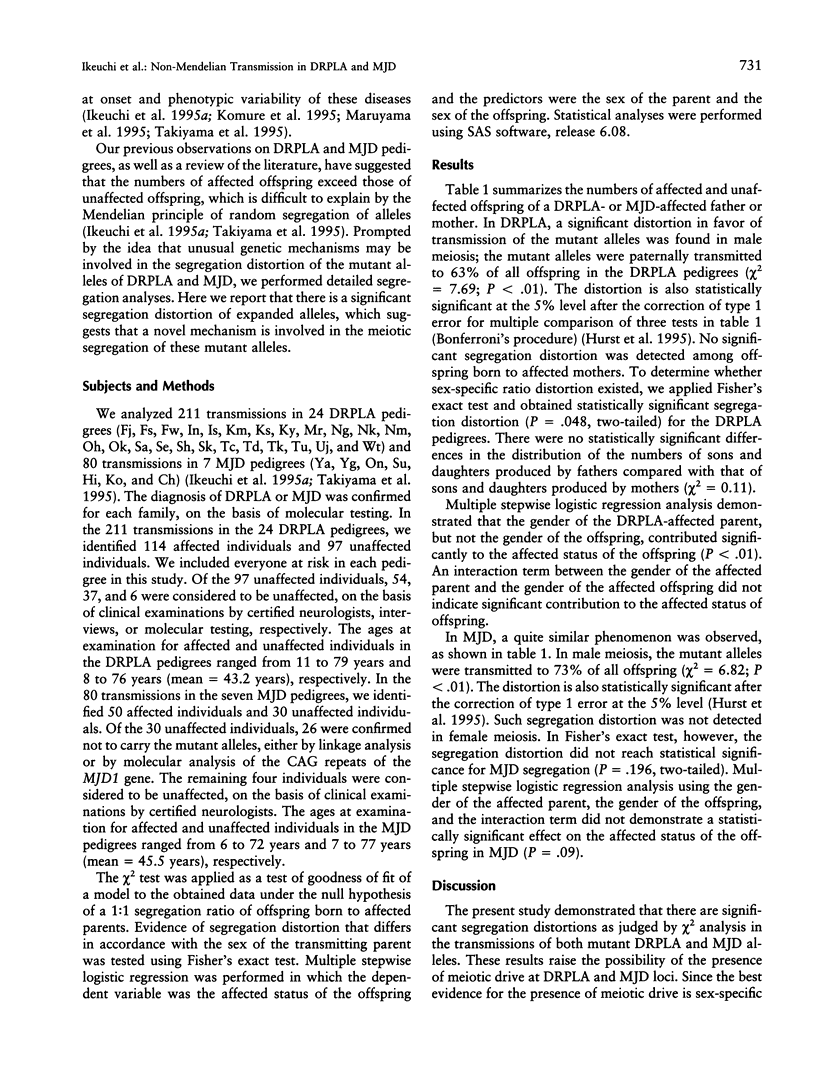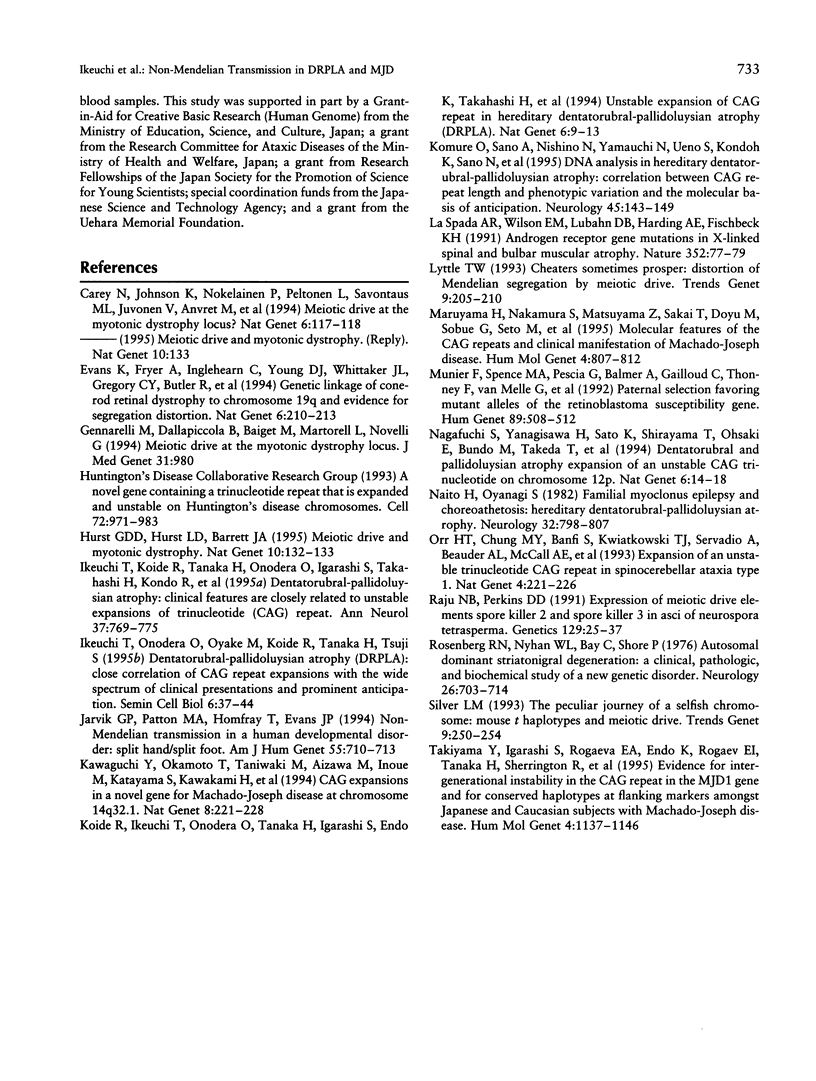Abstract
Autosomal dominant dentatorubral-pallidoluysian atrophy (DRPLA) and Machado-Joseph disease (MJD) are neurodegenerative disorders caused by CAG trinucleotide repeat expansions. An inverse correlation of age at onset with the length of the expanded CAG trinucleotide repeats has been demonstrated, and the intergenerational instability of the length of the CAG trinucleotide repeats, which is more prominent in paternal than in maternal transmissions, has been shown to underlie the basic mechanisms of anticipation in DRPLA and MJD. Our previous observations on DRPLA and MJD pedigrees, as well as a review of the literature, have suggested that the numbers of affected offspring exceed those of unaffected offspring, which is difficult to explain by the Mendelian principle of random segregation of alleles. In the present study, we analyzed the segregation patterns in 211 transmissions in 24 DRPLA pedigrees and 80 transmissions in 7 MJD pedigrees, with the diagnoses confirmed by molecular testing. Significant distortions in favor of transmission of the mutant alleles were found in male meiosis, where the mutant alleles were transmitted to 62% of all offspring in DRPLA (chi2 = 7.69; P<.01) and 73% in MJD (chi2 = 6.82; P<.01). The results were consistent with meiotic drive in DRPLA and MJD. Since more prominent meiotic instability of the length of the CAG trinucleotide repeats is observed in male meiosis than in female meiosis and meiotic drive is observed only in male meiosis, these results raise the possibility that a common molecular mechanism underlies the meiotic drive and the meiotic instability in male meiosis.
Full text
PDF



Selected References
These references are in PubMed. This may not be the complete list of references from this article.
- Carey N., Johnson K., Nokelainen P., Peltonen L., Savontaus M. L., Juvonen V., Anvret M., Grandell U., Chotai K., Robertson E. Meiotic drive at the myotonic dystrophy locus? Nat Genet. 1994 Feb;6(2):117–118. doi: 10.1038/ng0294-117. [DOI] [PubMed] [Google Scholar]
- Evans K., Fryer A., Inglehearn C., Duvall-Young J., Whittaker J. L., Gregory C. Y., Butler R., Ebenezer N., Hunt D. M., Bhattacharya S. Genetic linkage of cone-rod retinal dystrophy to chromosome 19q and evidence for segregation distortion. Nat Genet. 1994 Feb;6(2):210–213. doi: 10.1038/ng0294-210. [DOI] [PubMed] [Google Scholar]
- Gennarelli M., Dallapiccola B., Baiget M., Martorell L., Novelli G. Meiotic drive at the myotonic dystrophy locus. J Med Genet. 1994 Dec;31(12):980–980. doi: 10.1136/jmg.31.12.980. [DOI] [PMC free article] [PubMed] [Google Scholar]
- Hurst G. D., Hurst L. D., Barrett J. A. Meiotic drive and myotonic dystrophy. Nat Genet. 1995 Jun;10(2):132–133. doi: 10.1038/ng0695-132. [DOI] [PubMed] [Google Scholar]
- Ikeuchi T., Koide R., Tanaka H., Onodera O., Igarashi S., Takahashi H., Kondo R., Ishikawa A., Tomoda A., Miike T. Dentatorubral-pallidoluysian atrophy: clinical features are closely related to unstable expansions of trinucleotide (CAG) repeat. Ann Neurol. 1995 Jun;37(6):769–775. doi: 10.1002/ana.410370610. [DOI] [PubMed] [Google Scholar]
- Ikeuchi T., Onodera O., Oyake M., Koide R., Tanaka H., Tsuji S. Dentatorubral-pallidoluysian atrophy (DRPLA): close correlation of CAG repeat expansions with the wide spectrum of clinical presentations and prominent anticipation. Semin Cell Biol. 1995 Feb;6(1):37–44. doi: 10.1016/1043-4682(95)90013-6. [DOI] [PubMed] [Google Scholar]
- Jarvik G. P., Patton M. A., Homfray T., Evans J. P. Non-Mendelian transmission in a human developmental disorder: split hand/split foot. Am J Hum Genet. 1994 Oct;55(4):710–713. [PMC free article] [PubMed] [Google Scholar]
- Kawaguchi Y., Okamoto T., Taniwaki M., Aizawa M., Inoue M., Katayama S., Kawakami H., Nakamura S., Nishimura M., Akiguchi I. CAG expansions in a novel gene for Machado-Joseph disease at chromosome 14q32.1. Nat Genet. 1994 Nov;8(3):221–228. doi: 10.1038/ng1194-221. [DOI] [PubMed] [Google Scholar]
- Koide R., Ikeuchi T., Onodera O., Tanaka H., Igarashi S., Endo K., Takahashi H., Kondo R., Ishikawa A., Hayashi T. Unstable expansion of CAG repeat in hereditary dentatorubral-pallidoluysian atrophy (DRPLA). Nat Genet. 1994 Jan;6(1):9–13. doi: 10.1038/ng0194-9. [DOI] [PubMed] [Google Scholar]
- Komure O., Sano A., Nishino N., Yamauchi N., Ueno S., Kondoh K., Sano N., Takahashi M., Murayama N., Kondo I. DNA analysis in hereditary dentatorubral-pallidoluysian atrophy: correlation between CAG repeat length and phenotypic variation and the molecular basis of anticipation. Neurology. 1995 Jan;45(1):143–149. doi: 10.1212/wnl.45.1.143. [DOI] [PubMed] [Google Scholar]
- La Spada A. R., Wilson E. M., Lubahn D. B., Harding A. E., Fischbeck K. H. Androgen receptor gene mutations in X-linked spinal and bulbar muscular atrophy. Nature. 1991 Jul 4;352(6330):77–79. doi: 10.1038/352077a0. [DOI] [PubMed] [Google Scholar]
- Lyttle T. W. Cheaters sometimes prosper: distortion of mendelian segregation by meiotic drive. Trends Genet. 1993 Jun;9(6):205–210. doi: 10.1016/0168-9525(93)90120-7. [DOI] [PubMed] [Google Scholar]
- Maruyama H., Nakamura S., Matsuyama Z., Sakai T., Doyu M., Sobue G., Seto M., Tsujihata M., Oh-i T., Nishio T. Molecular features of the CAG repeats and clinical manifestation of Machado-Joseph disease. Hum Mol Genet. 1995 May;4(5):807–812. doi: 10.1093/hmg/4.5.807. [DOI] [PubMed] [Google Scholar]
- Munier F., Spence M. A., Pescia G., Balmer A., Gailloud C., Thonney F., van Melle G., Rutz H. P. Paternal selection favoring mutant alleles of the retinoblastoma susceptibility gene. Hum Genet. 1992 Jul;89(5):508–512. doi: 10.1007/BF00219175. [DOI] [PubMed] [Google Scholar]
- Nagafuchi S., Yanagisawa H., Sato K., Shirayama T., Ohsaki E., Bundo M., Takeda T., Tadokoro K., Kondo I., Murayama N. Dentatorubral and pallidoluysian atrophy expansion of an unstable CAG trinucleotide on chromosome 12p. Nat Genet. 1994 Jan;6(1):14–18. doi: 10.1038/ng0194-14. [DOI] [PubMed] [Google Scholar]
- Naito H., Oyanagi S. Familial myoclonus epilepsy and choreoathetosis: hereditary dentatorubral-pallidoluysian atrophy. Neurology. 1982 Aug;32(8):798–807. doi: 10.1212/wnl.32.8.798. [DOI] [PubMed] [Google Scholar]
- Orr H. T., Chung M. Y., Banfi S., Kwiatkowski T. J., Jr, Servadio A., Beaudet A. L., McCall A. E., Duvick L. A., Ranum L. P., Zoghbi H. Y. Expansion of an unstable trinucleotide CAG repeat in spinocerebellar ataxia type 1. Nat Genet. 1993 Jul;4(3):221–226. doi: 10.1038/ng0793-221. [DOI] [PubMed] [Google Scholar]
- Raju N. B., Perkins D. D. Expression of meiotic drive elements Spore killer-2 and Spore killer-3 in asci of Neurospora tetrasperma. Genetics. 1991 Sep;129(1):25–37. doi: 10.1093/genetics/129.1.25. [DOI] [PMC free article] [PubMed] [Google Scholar]
- Rosenberg R. N., Nyhan W. L., Bay C., Shore P. Autosomal dominant striatonigral degeneration. A clinical, pathologic, and biochemical study of a new genetic disorder. Neurology. 1976 Aug;26(8):703–714. doi: 10.1212/wnl.26.8.703. [DOI] [PubMed] [Google Scholar]
- Silver L. M. The peculiar journey of a selfish chromosome: mouse t haplotypes and meiotic drive. Trends Genet. 1993 Jul;9(7):250–254. doi: 10.1016/0168-9525(93)90090-5. [DOI] [PubMed] [Google Scholar]
- Takiyama Y., Igarashi S., Rogaeva E. A., Endo K., Rogaev E. I., Tanaka H., Sherrington R., Sanpei K., Liang Y., Saito M. Evidence for inter-generational instability in the CAG repeat in the MJD1 gene and for conserved haplotypes at flanking markers amongst Japanese and Caucasian subjects with Machado-Joseph disease. Hum Mol Genet. 1995 Jul;4(7):1137–1146. doi: 10.1093/hmg/4.7.1137. [DOI] [PubMed] [Google Scholar]


